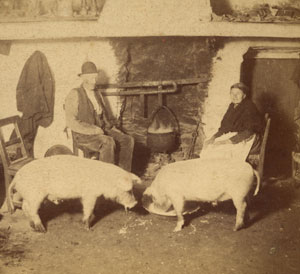Annotation:Pig in the Parlour: Difference between revisions
(Created page with "=='''Back to [[{{BASEPAGENAME}}]]'''== ---- <p><font face="garamond, serif" size="4"> '''PIG IN THE PARLOUR'''. English, Reel or Country Dance Tune (cut time). F Major. Stand...") |
No edit summary |
||
| Line 5: | Line 5: | ||
<br> | <br> | ||
<br> | <br> | ||
[[File:pigparlour.jpg|300px|thumb|left|]] | |||
"Pig in a Parlour" has long been an English metaphor for something out of place, and perhaps unwelcome. So too, if one puts a 'pig in a parlour', it is still a pig (i.e. context does not alter character). | "Pig in a Parlour" has long been an English metaphor for something out of place, and perhaps unwelcome. So too, if one puts a 'pig in a parlour', it is still a pig (i.e. context does not alter character). | ||
<br> | <br> | ||
Revision as of 04:07, 26 August 2016
Back to Pig in the Parlour
PIG IN THE PARLOUR. English, Reel or Country Dance Tune (cut time). F Major. Standard tuning (fiddle). AABB. The melody and country dance directions were first printed in London by music publisher John Walsh in his Second Book of the Compleat Country Dancing-Master, 3rd edition (1735), and in later editions of the same volume. It was also printed by John Johnson in his Choice Collection of 200 Favourite Country Dances, vol. 3 (1744) and by John Simpson in The Delightful Pocket Companion, vol. 2 (c. 1750). London musician Thomas Hammersely entered it into his 1790 music manuscript collection (as "Pig in Ye Parlour").

"Pig in a Parlour" has long been an English metaphor for something out of place, and perhaps unwelcome. So too, if one puts a 'pig in a parlour', it is still a pig (i.e. context does not alter character).
Source for notated version:
Printed sources: Walsh (The Second Book of the Compleat Country Dancing-Master, 3rd edition), London, 1735; No. 14.
Recorded sources:
